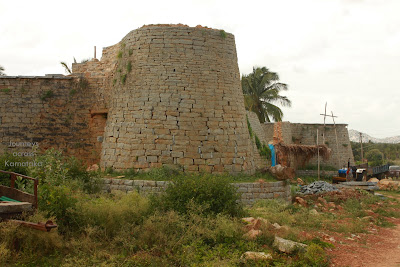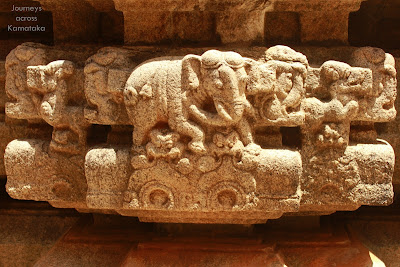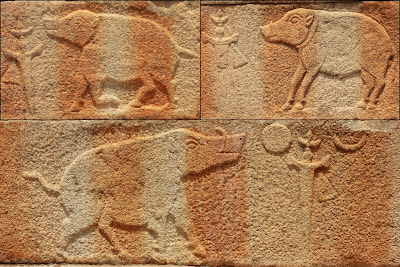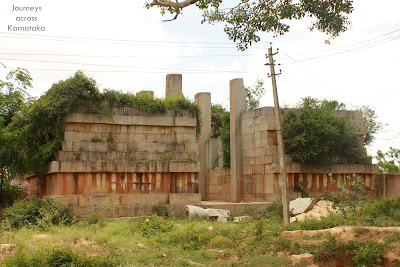Being powerful chieftain, Bise Gowda had constructed a fort for himself at Harappanayakanahalli. The fort, a 200' x 200' x 18' high stone walled structure, stands to this day. His descendants live in the fort, of course the structure has been altered in recent years. Bise Gowda did not have sons, hence his descendants are his daughter’s.
August 14, 2012
While on a tour of forts between Bangalore and Chikballapur, I happened to mention Bise Gowda to my cab driver Sudhakar. He had heard a story which goes like this: One day when Bise Gowda was watching over his lands in his territory, few people of butcher community were carrying meat filled cane baskets. One of the baskets had a matchet on the top. Now, that matchet was not an ordinary one. Kites flying by swooped down to grab pieces flesh from the baskets.. but when the kites flew by the matchet would take off and chased away the birds. Bise Gowda who was watching the happenings was astonished, he also noticed that folks carrying the baskets were not aware of the magical powers of the matchet. After a while Bise Gowda approaches them and gets the matchet for himself. Then he gets the matchet forged into a sword with which he fights and wins several battles. However during one raid he attacks a pregnant woman who curses him to before dying. Well, that's the story I heard but can't remember the last part which is about the effect of the woman's curse and Bise Gowda's death.
August 17, 2012
After the tour of Chola temples at Avani we arrive at Harappanayakanahalli. A local folk confused us we took a round about route to the fort. The fort is a square in plan with four circular bastions.
It's not a easy task to maintain ancient building, that's mainly because of lack of manpower and costs involved.
As we approached the fort, we saw a lady at the entrance, she wasn't happy seeing us. She asked us who we were in a authoritative tone.. I guessed the lady was from Bise Gowda's family. I told the lady about the little adventure in reaching her fort.. we are here to see the legendary Kaki Bise Gowda's fort, if permitted. The lady thawed and let us in.
Our host told us about the ongoing repair work. We could see a mason and his help busy moving and arranging dressed granite slabs.
The fort's original entrance is south-facing. Part of the eastern wall was broken down to make a new entrance. Thanks to Vaastu.
Within the fort is a tiled roof house, an open well and a cattle house. The well was not circular but a square lined with granite slabs. Water level in the well was quite high, perhaps 4 feet below ground level. On the right is a modern cement and steel structure under construction.
The lady was kind of friendly now, she showed us the massive stone grinder used to make flour. The grinder was used even during Bise Gowda's time. Our host also mentioned about artifacts from Bise Gowda's time. I was temped to ask if we could see, but decided against it.
Repairing old structures isn't an easy job. The lady offers us tea but we decline the offer politely. It was time to leave, we still has Kurudumale on our list.
The North-East bastion.
That's the new entrance, next to the NE bastion.
On the village outskirts this cone-on-cylinder hut caught our attention. The conical wall is made of dresses stones and the roof is palm leaves. This was a human dwelling earlier, now its used as a cattle house.
Notice the shallow pit around the base of the wall. Seems like a snake-pit.
Two more houses on a granite hillock. Similar houses in Kutch region are known by the name Bhonga.
While driving through the countryside I noticed life is still simple and seems peaceful. We drive towards the Hoysala capital Kurudumale.
Kaki Bise Gowda Fort Coordinates: 13°15'6"N 78°23'4"E
.........






























































